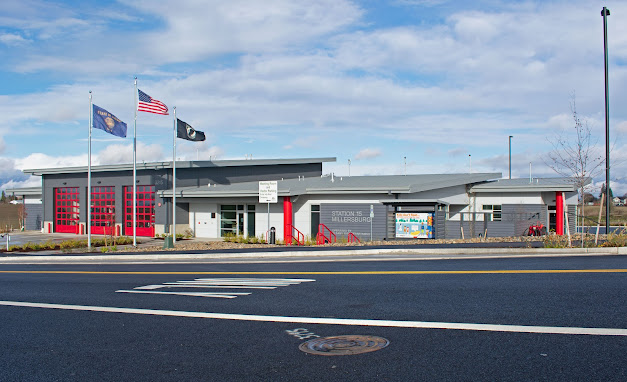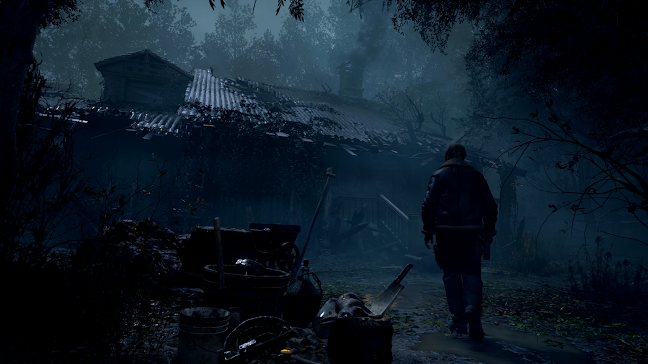Photo Story - Station 15 and It's Firefighters
Millersburg, Oregon has a brand new fire station. Opened on June 30, 2022, Station 15 is the 5th fire station in the emergency service network run by the Albany Fire Department. The station is unique in that it was built and paid for by the City of Millersburg, but the services are contracted out to and run by the Albany Fire Department. Municipal fire departments are made up of either volunteer or professional firefighters. Volunteer firefighters are defined by the National Fire Protection Association as unpaid or nominally paid, on-call firefighters. Roughly 70% of firefighters in the United States are volunteers. To contrast this the Albany Fire Department is staffed by professional firefighters. Professional firefighters are salaried and on staff at all times. The certifications held by professional firefighters are typically higher than volunteer firefighters. The Albany Fire Department requires all its firefighters to also have EMT certification, and many also have paramedic certifications.
The new facility cost an estimated $13.5 million and took about a year and a half to complete. Station 15 is The station has redundant infrastructure systems built in to assist with city operation in case of emergency. This new station is capable of being the city headquarters in case of emergency. An emergency operations center, EOC, was designed into the facilities from the onset. The EOC has a full telecommunications suite which allows all city functions to be run from it, especially emergency services. The station currently is run by three full time firefighters at all times, which is one full apparatus crew. An apparatus being an emergency operations vehicle. This can include an ambulance, a fire engine, a water tender, or a ladder truck, among others. A crew is made up of a Lieutenant, who provides immediate on the ground leadership, an Apparatus Operator, AO, who drives and operates the equipment on an apparatus, and a firefighter. The crews observed at Station 15 were composed of a Lieutenant and two Apparatus Operators. The station is designed to eventually have two full crews, or six on duty firefighters, housed there as the community expands.
An Albany Fire Department firefighter’s shift starts at 7am at the shift change. Shifts are 24 hours long and follow a one day on, two days off rotation. Three crews will rotate to provide 24/7 coverage of emergency services for the community. Lt. Steven Lehman broke down the average day of a firefighter. After the shift change most firefighters will do some kind of workout. Station 15 has a full in house gym and many take advantage of the facility. After working out they will do an equipment check. They use an application on their work phones that gives them a checklist of the equipment each firefighter is responsible for to aid them in making sure all equipment is in full working order. It is helpful because if they get interrupted by a call they know exactly what equipment still needs to be checked when they return. The equipment check takes an estimated 30-45 minutes each day. At this point many will have breakfast from the large communal kitchen.
After breakfast each firefighter will work on their independent work. Their independent work mostly consists of writing incident reports. Incident reports are detailed breakdowns of actions taken by the firefighters at the scene of an emergency. These are important because the vast majority, estimated to be about 85% by the crews at Station 15, to be medical emergencies. The information in the incident reports will be transmitted to the hospital so doctors know all treatments and medications given by the firefighters to the patient. Incident reports are also important for accountability of conduct at an emergency to the fire department, the city and the public. Other independent work a firefighter might work on is training for qualifications. Some of this training can be done online or through remote conference meetings. Some hands-on or instructed training can be performed in the station under the supervision of a Lieutenant or other ranking firefighters. Other training may require a firefighter to go to a certain location or station where the training is held. Because firefighters are on duty their full 24 hour shift, their shifts will be covered for intensive or off site training. Independent work would be done until the evening with a lunch break in the middle. In the evening, firefighters will have dinner and break period before turning in for the night. Firefighters do sleep during their 24 shifts. All three members of the crew go to sleep at the same time, with nobody having to stand watch overnight. Each firefighter has their own dorm room, which has a bed and a small desk. The dorm rooms at Station 15 are designed to block out all light so the station itself can be well lit but the firefighters can get good rest. The windows have frame mounted black out curtains and the door has a seal at the bottom to ensure that the dorm room is completely dark. In case of an emergency call at night the entire room lights up red and a loud alarm is sounded. Lt. Lehman states that none of the firefighters have any problems waking up in case of emergency.
Other than independent work, firefighters have specific tasks posted by the lieutenant each day. Sometimes this can be community outreach like visiting a school or entertaining local community college reporters. The lieutenant might also work on situational preplaning. Millersburg has a lot of industrial manufacturing like the Palm Harbor Homes manufacturing facility and the ATI Wah Chang titanium refinery. These large scale commercial or heavy industry facilities have the potential to be a huge fire risk. The lieutenant can visit these businesses before an incident and map out where all emergency systems are for better response capability if the need arises. These systems include where dangerous chemicals are located and the location of fire hydrants. Also what sprinkler systems are in the building and what external access there is to the systems. Firefighters can hook a fire engine to the external access to increase the water pressure of the sprinkler systems to better put out fires.
The life of a firefighter is not easy. Every week each member of a crew will work 48 to 72 hours. On top of all the prior listed duties, firefighters are on call to respond to an emergency at a moment's notice. During an interview, the firefighters of Station 15 were alerted to an emergency. From sitting at the dining table in the kitchen to fully suited up and in their apparatus took about three minutes. They were even able to spring to action before the alarm went off in the station. Each firefighter has an application on their phone which allows them to monitor incoming emergency calls as a dispatcher is receiving them. If the lieutenant sees that the call is coming from their area of operation then the crew will preemptively get ready to go out on that call. Lt. John Ellich described how the information received via this application allowed him to coordinate emergency services better. All fire departments surrounding Albany have a mutual assistance network where departments will assist on out of district calls. The application the firefighters use can see emergency dispatch from surrounding areas too.
Being a firefighter is also difficult due to the mental stress of the job. AO Tom Henke said the one day on, two day off scheduling to be a perk of the job. That the two days off allowed him to pursue his leisure, which in this case was skiing. He also said that some days on the job are very difficult psychologically. Oftentimes, firefighters deal with people on the worst days of their life. They might receive a call where people are gravely wounded or sick. Henke said that it can be hard to want to come in to work the next day, so the two days off allows him to decompress and refocus. Being a firefighter can also be hard if they have families. Sometimes their schedule has them working on important dates or holidays. They also aren’t available if personal emergencies arise without getting someone to substitute for them. Families are allowed to visit them at the station though. AO Henke said it's often easier to postpone holidays to a day off rather than do something at the station.
Station 15 is the newest part of the Albany / Millersburg emergency service network. The few, dedicated professional firefighters of the Albany Fire Department work around the clock to provide emergency services to the cities. The new facilities of Station 15 provide the emergency service network to cater to the growing Millersberg community.







Comments
Post a Comment